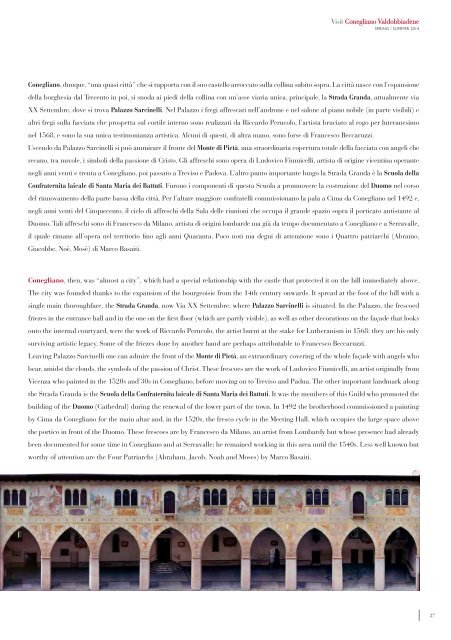visit_conegliano_valdobbiadene_2014
visit_conegliano_valdobbiadene_2014
visit_conegliano_valdobbiadene_2014
Create successful ePaper yourself
Turn your PDF publications into a flip-book with our unique Google optimized e-Paper software.
Visit Conegliano Valdobbiadene<br />
SPRING / SUMMER <strong>2014</strong><br />
Conegliano, dunque, “una quasi città” che si rapporta con il suo castello arroccato sulla collina subito sopra. La città nasce con l’espansione<br />
della borghesia dal Trecento in poi, si snoda ai piedi della collina con un’asse viaria unica, principale, la Strada Granda, attualmente via<br />
XX Settembre, dove si trova Palazzo Sarcinelli. Nel Palazzo i fregi affrescati nell’androne e nel salone al piano nobile (in parte visibili) e<br />
altri fregi sulla facciata che prospetta sul cortile interno sono realizzati da Riccardo Perucolo, l’artista bruciato al rogo per luteranesimo<br />
nel 1568, e sono la sua unica testimonianza artistica. Alcuni di questi, di altra mano, sono forse di Francesco Beccaruzzi.<br />
Uscendo da Palazzo Sarcinelli si può ammirare il fronte del Monte di Pietà, una straordinaria copertura totale della facciata con angeli che<br />
recano, tra nuvole, i simboli della passione di Cristo. Gli affreschi sono opera di Ludovico Fiumicelli, artista di origine vicentina operante<br />
negli anni venti e trenta a Conegliano, poi passato a Treviso e Padova. L’altro punto importante lungo la Strada Granda è la Scuola della<br />
Confraternita laicale di Santa Maria dei Battuti. Furono i componenti di questa Scuola a promuovere la costruzione del Duomo nel corso<br />
del rinnovamento della parte bassa della città. Per l’altare maggiore confratelli commissionano la pala a Cima da Conegliano nel 1492 e,<br />
negli anni venti del Cinquecento, il ciclo di affreschi della Sala delle riunioni che occupa il grande spazio sopra il porticato antistante al<br />
Duomo. Tali affreschi sono di Francesco da Milano, artista di origini lombarde ma già da tempo documentato a Conegliano e a Serravalle,<br />
il quale rimane all’opera nel territorio fino agli anni Quaranta. Poco noti ma degni di attenzione sono i Quattro patriarchi (Abramo,<br />
Giacobbe, Noè, Mosè) di Marco Basaiti.<br />
Conegliano, then, was “almost a city”, which had a special relationship with the castle that protected it on the hill immediately above.<br />
The city was founded thanks to the expansion of the bourgeoisie from the 14th century onwards. It spread at the foot of the hill with a<br />
single main thoroughfare, the Strada Granda, now Via XX Settembre, where Palazzo Sarcinelli is situated. In the Palazzo, the frescoed<br />
friezes in the entrance hall and in the one on the first floor (which are partly visible), as well as other decorations on the façade that looks<br />
onto the internal courtyard, were the work of Riccardo Perucolo, the artist burnt at the stake for Lutheranism in 1568: they are his only<br />
surviving artistic legacy. Some of the friezes done by another hand are perhaps attributable to Francesco Beccaruzzi.<br />
Leaving Palazzo Sarcinelli one can admire the front of the Monte di Pietà, an extraordinary covering of the whole façade with angels who<br />
bear, amidst the clouds, the symbols of the passion of Christ. These frescoes are the work of Ludovico Fiumicelli, an artist originally from<br />
Vicenza who painted in the 1520s and’30s in Conegliano, before moving on to Treviso and Padua. The other important landmark along<br />
the Strada Granda is the Scuola della Confraternita laicale di Santa Maria dei Battuti. It was the members of this Guild who promoted the<br />
building of the Duomo (Cathedral) during the renewal of the lower part of the town. In 1492 the brotherhood commissioned a painting<br />
by Cima da Conegliano for the main altar and, in the 1520s, the fresco cycle in the Meeting Hall, which occupies the large space above<br />
the portico in front of the Duomo. These frescoes are by Francesco da Milano, an artist from Lombardy but whose presence had already<br />
been documented for some time in Conegliano and at Serravalle; he remained working in this area until the 1540s. Less well known but<br />
worthy of attention are the Four Patriarchs (Abraham, Jacob, Noah and Moses) by Marco Basaiti.<br />
27


